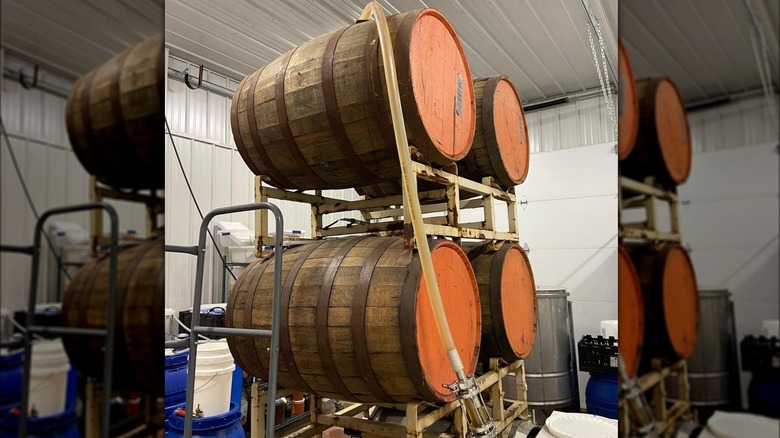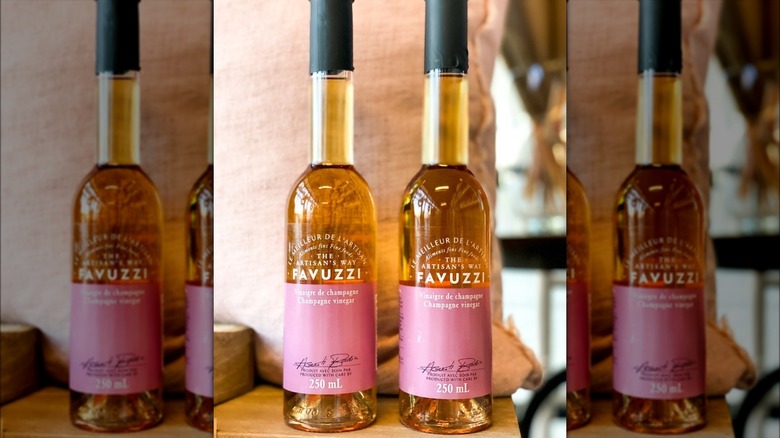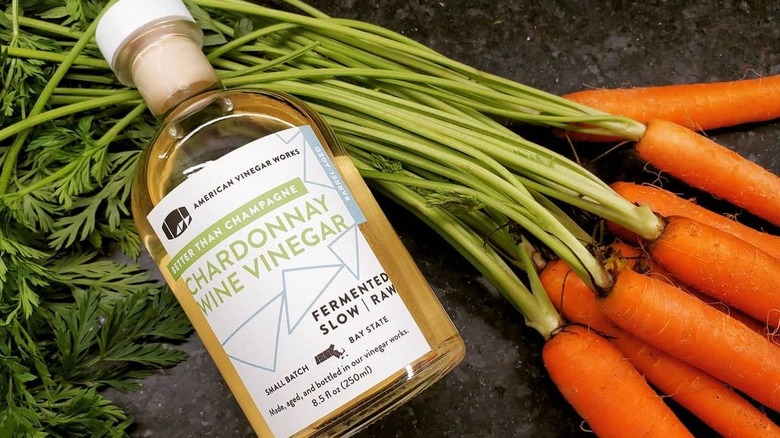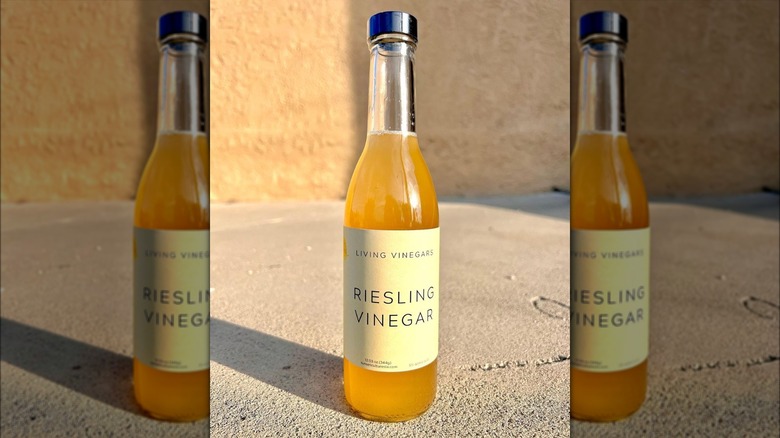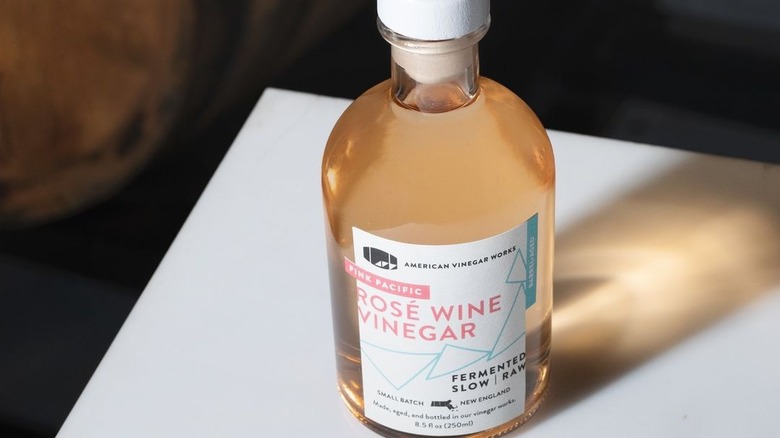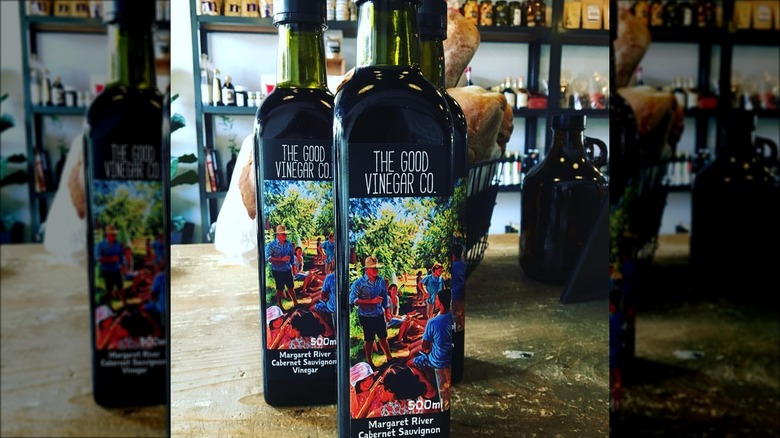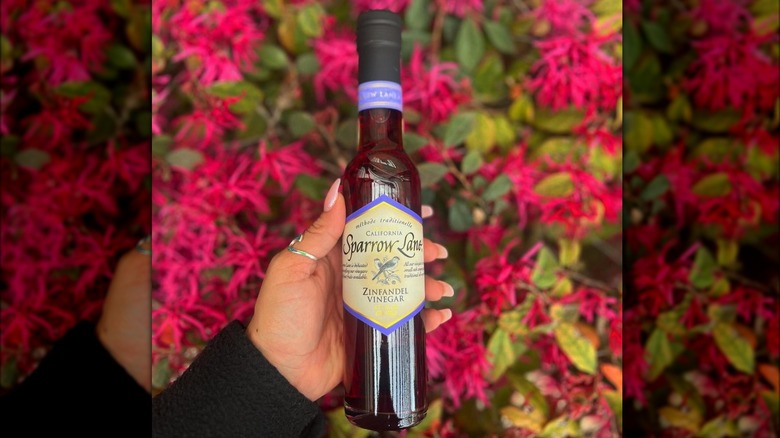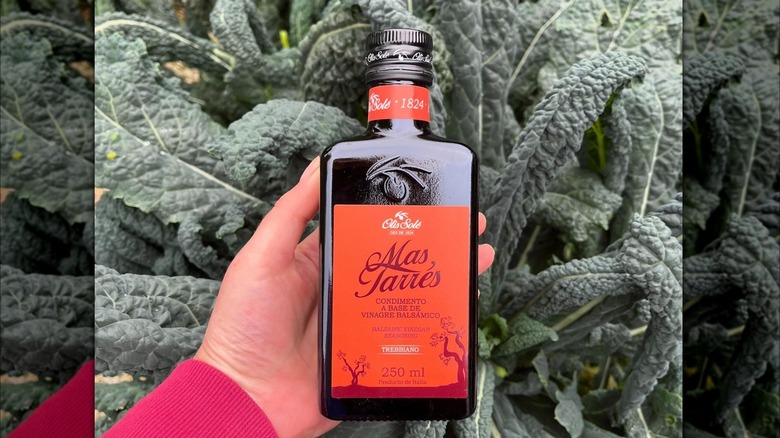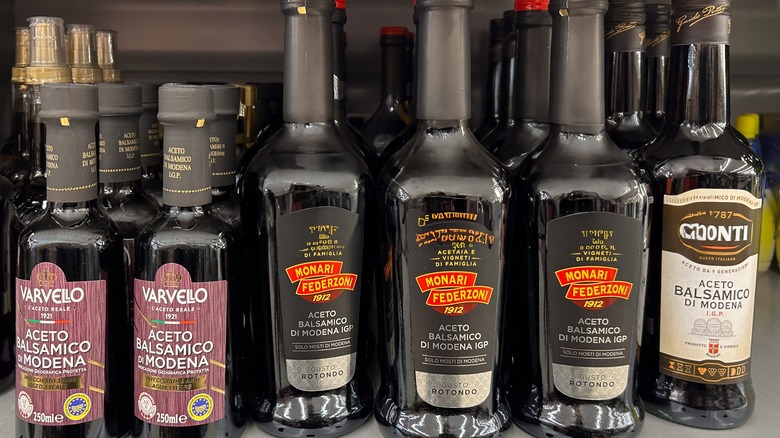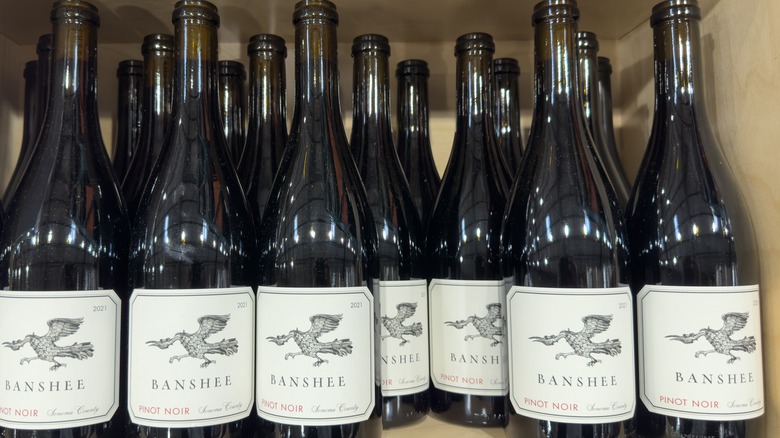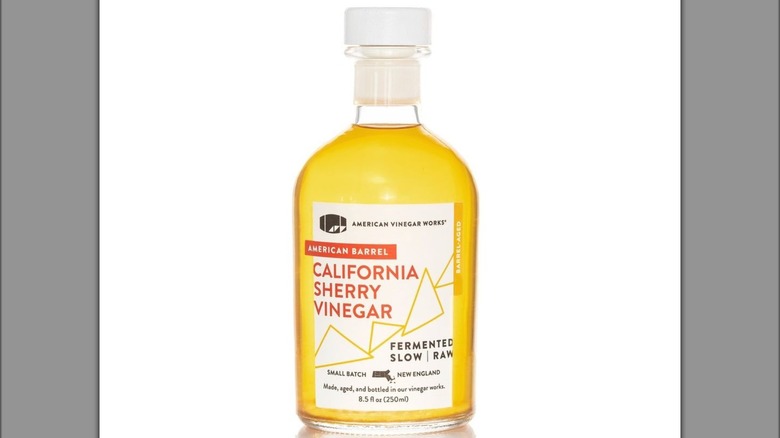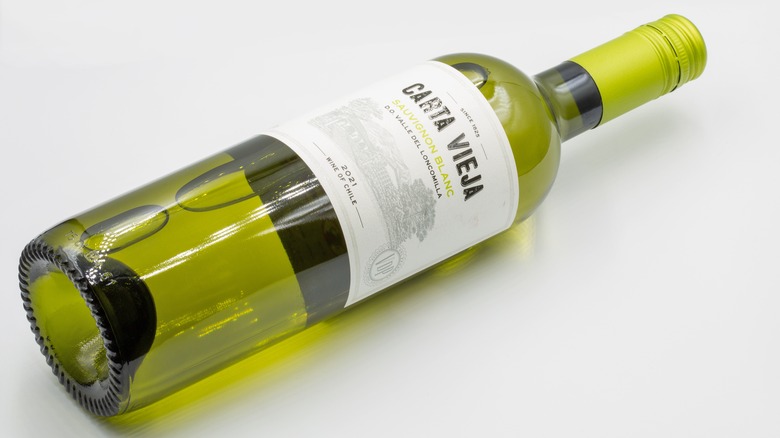11 Best Wines For Making Your Own Vinegar
Condiments (which can be difficult to define) are often an afterthought, yet they have the ability to seriously transform a dish. Consider how something as simple as salt can instantly enhance the flavors of a meal. Now, when it comes to vinegar, many stick to basics like balsamic and apple cider. But there's a world of vinegar options available beyond the staples. While you can always pick up a generic red or white wine vinegar from the store, artisanal vinegar makers tend to highlight the nuances of specific wine varieties — and you can, too.
Anyone can make their own wine-based vinegar at home, and there's plenty of leeway to do your own thing. To learn more about the specifics of this process, though, I spoke to a pair of vinegar producers: Justin Dean, co-owner and acid alchemist at The MadHouse Vinegar Co., and Rodrigo Vargas, founder of American Vinegar Works.
Known for making high-quality products that are praised across the country, these two experts shared their insights into the sour world of vinegar, including what to look for when choosing wines for a vinegar-making project. As a Certified Specialist of Wine, I combined my own expertise with the advice received from each professional vinegar maker, and present the best wines to use for making your own vinegar.
Getting started making vinegar
Before selecting the ideal wines to make your vinegar, it's worth understanding some of the ins and outs of the process. Thankfully, as Justin Dean noted, "Vinegar making is super simple and mother nature does most of the work for you." When wine comes in contact with oxygen, it forms acetic acid, which is the basis of vinegar. A slow fermentation then helps build a well-rounded taste, while oak aging further assists the development of balance.
Now, according to Rodrigo Vargas, it's important to start with a quality wine to avoid off-flavors or an underdeveloped taste. "We have found that bigger and bolder tasting wines make for better vinegars," Vargas told us, further stating "this stands in contrast to wine styles that are more minerally or tart." Consequently, American Vinegar Works typically uses chardonnay, shiraz, and Pedro Ximenez grapes (to name a few), all of which are grown in the U.S.
On the other hand (and unlike Vargas), Dean believes you don't have to splurge on a good bottle of wine to make tasty vinegar. He explained "the secondary fermentation from alcohol to vinegar blows out most all faults in the wine base we start with." While he mentioned MadHouse relies on upcycled wine and therefore does not select specific grape varieties, the wines are still blended to produce optimal flavors.
Champagne
To be fair, we're starting off pretty strong by suggesting a luxurious wine. But there's no denying Champagne vinegar is a delicious addition to any table. Depending on your budget, you may want to stick to a small batch of vinegar, or look beyond a top-tier wine bottle. Of course, if you're hosting a party and multiple bottles are flowing, any leftover Champagne that's lost its sparkle will be perfect for this purpose.
Champagne is typically made with either (or both) pinot noir and chardonnay grapes, with a couple of others blended in on occasion, too. To create the carbonation, a base wine goes through a secondary fermentation, leading to some preliminary transformations that are further developed as the wine turns into vinegar. As a vinegar, the resulting flavors are floral and delicate, with a pleasant subtlety and vibrant taste that pairs well with olive oil (plus the other ingredients on your plate).
Be sure to match Champagne vinegar with similarly soft flavors to avoid washing out the taste. Highlight its nuances by using it as the primary vinegar for pickling, or combine it with minced shallots, lemon, extra virgin olive oil, sugar, salt, and pepper for an easy vinaigrette. A salad drizzled with a Champagne vinaigrette is nothing to scoff at, after all.
Chardonnay
Chardonnay is a ubiquitous wine grape grown around the world, making it an excellent candidate for your at-home vinegar experiments. It quickly takes on flavors from its environment and the cellar, so you can expect a range of flavors depending on its source. The grape is known for its fresh and fruity characteristics and suitability for oak aging, and vinegar makers often treat chardonnay in a similar fashion by letting it mature in oak barrels. This helps soften the acidity while adding complexity to the taste.
Chardonnay vinegar maintains a refreshing quality while being more rounded on the palate, infusing your dishes with a hint of oak and a sweeter element. Now, in all likelihood, you don't have an wooden barrel lying around your kitchen — and you probably don't want to make the volumes of vinegar that would fit into one. However, if making vinegar is your passion project, you might want to invest in a small 1-liter barrel.
Thankfully, if you aren't looking to purchase a barrel, you can mimic that effect by choosing an oaked chardonnay wine to work with. Once it's made, pair chardonnay vinegar with Mediterranean and seafood dishes for a lively taste.
Riesling
The riesling grape is known for its aromatic profile and notable acidity, and you can bet that translates into a delicious vinegar. Furthermore, riesling is regularly vinified as an off-dry or dessert wine, which provides even more options for your vinegar-making experiments. Many artisanal riesling vinegars are made with late harvest wine, which contains elevated levels of sugar. Consequently, if you let it become vinegar, you'll end up with a rich sweetness and zesty acidity to balance it out.
Citrus fruit and elegant floral notes are present on the palate in riesling-based vinegars, making this a delightful option for salad dressings and garnishes. Drizzle it over grilled white fish and pair it with a fruit salsa for a tantalizing feast. Alternatively, you could serve it with garlic-infused olive oil and use it as a fragrant bread dip. You can easily incorporate it into desserts and fruit salads to add a tangy hint, as well, if you choose a sweeter bottle of riesling as the base.
Rosé
Rosé wines can be made with a wide range of red grape varieties, producing very different outcomes in the glass. Since the wine is made with minimal contact between the grape skins and juice, it's lighter on the palate than if it had been vinified as a red wine. As such, the resulting vinegar is delicate and subtle, with a crisp nature that's characteristic of rosé.
If you're working with a bottle of Provence rosé, expect a lighter citrus style, whereas a Spanish rosé made with tempranillo grapes might be bolder. Meanwhile, if you're looking for sweetness, then start with an off-dry rosé from the Loire Valley in France or California. According to Rodrigo Vargas, California rosé wines made with Italian varieties are commonly used for the rosé vinegar at American Vinegar Works.
This type of wine-derived vinegar works well over salad greens, as a glaze for seafood, or reduced to a sticky sauce that goes well with goat cheese. Additionally, thanks yo its fruity touch, rosé vinegar is a great place to start experimenting with vinegar or shrubs in your cocktails.
Cabernet sauvignon
Cabernet sauvignon might be your go-to pairing for a juicy steak, but the wine also holds up well to the vinegar-making process. After all, as Rodrigo Vargas pointed out, weighty wine styles with bold flavors translate well into vinegar. As the wine ferments and mellows over time, the tannin structure becomes subtler and the acetic acid adds a freshness to the taste.
Now, it's common to let cabernet sauvignon vinegar mature in oak barrels, which rounds it out for a balanced result. You can mimic this effect with small barrels, of course, or choose a bottle with a notable oak presence. Furthermore, cabernet sauvignon wines from Argentina or Chile offer a good value, allowing you a bit of leeway for vinegar experimentation before splurging on something more expensive.
Combine this vinegar with shallots to make a complex vinaigrette for hearty greens like radicchio, or add a splash to a tomato-based pasta sauce for brightness (per Vargas' advice). You could also use it in a red meat marinade that stands up to the rich flavors, or simply add it to the pan to deglaze.
Zinfandel
Zinfandel has a powerful taste that transforms into a nuanced vinegar with robust aromas. You can try a bottle of California zinfandel to maximize the juicy and jammy berry notes, or scoop up a bottle of primitivo from Southern Italy. Both zinfandel and primitivo are clones of a Croatian wine grape and share many features, though primitivo is a bit earthier with darker fruit notes. Either one makes an excellent vinegar, with or without oak aging (though, again, a small barrel really is a good investment if you're serious about making vinegar).
Aside from berry notes, some zinfandel wines bring a bit of spice and smokiness into the glass. Once it ferments into vinegar, then, you'll have a deliciously savory product that does more than just add a touch of acidity to your dishes. Much like with zinfandel wine, consider pairing this tart condiment with a juicy burger or steak; you may even want to use it to pickle red onions for the ultimate burger topping. Thanks to the tangy fruit notes and hint of spice, a zinfandel vinaigrette is also a delicious match for a Greek salad.
Trebbiano
True balsamic vinegar from Modena, Italy must follow strict regulations to be labeled as such — meaning most white balsamic vinegars aren't the real deal. Of course, that doesn't mean variations aren't sold all over. When you pick up white balsamic from the store, chances are it's made primarily with trebbiano, which are wine grapes common in the Italian vinegar producing region. So if you want to recreate a version of white balsamic vinegar, reach for a bottle of trebbiano.
As one of the most planted wine grapes in the world (notably in Italy and in France as ugni blanc), there are plenty of affordable bottles to be found. If you want to channel some semblance of balsamic tradition, then reach for an Italian trebbiano wine. The taste is fairly neutral, with citrusy notes and hints of almond. Once it becomes vinegar, the tartness shines through, making it an excellent option to whisk into a tangy salad vinaigrette. Plus, if you let it sit for a few weeks in an oak barrel — or months (if you're patient!) — the vinegar will have a mellower rounded taste.
Sangiovese
Sangiovese is the main grape of the Chianti region in Tuscany, and it also happens to be one of the standard wine grapes used for traditional balsamic vinegar. Considering the product is internationally recognized for its delicious flavors, you could do worse than transform a bottle of Chianti into vinegar.
There are many categories of Chianti, but you don't have to shell out for the priciest for this purpose. As long as you're choosing a bottle with a DOC label indicating a certain level of quality, you'll be working with decent wine to produce your vinegar. When sangiovese grapes are fermented into vinegar, the result is a concentrated flavor with rich fruit notes. There might be some sweetness to counter the acidity, along with notes of fruits like figs and plums. Serve it with grilled vegetables, meat or bean stews, or as a simple and fragrant salad dressing paired with extra virgin olive oil.
Pinot noir
Pinot noir is a versatile wine — one with a quality that persists if you choose to turn a bottle into vinegar. There are plenty of styles of pinot, from fruitier versions to savory wines with notes of earth and mushrooms. Consequently, you can create very different vinegar products depending on which bottle of pinot noir you start with. Taking Rodrigo Vargas' advice into consideration, a bold and fruity new world pinot noir would make a great contender. With that in mind, look for bottles from California, New Zealand, or Chile to get started.
The resulting vinegar is sure to be bold and rich, with red fruit notes and a balanced acidity. As with other red wines, aging it in a small barrel will add layers of nuance and complexity, but it's not necessary. Pinot noir vinegar is also great for pickling, as well as marinating or seasoning poultry dishes. Roast chicken or stews with plenty of fresh herbs will be instantly elevated by a splash of this tasty vinegar.
Sherry
You might not consume sherry as often as you do a regular table wine ... but it is still wine. There are several types of sherry which can produce an equally diverse selection of vinegars once the acetic acid sets in.
If you're looking for something light and zesty, stick with the driest style, such as a bottle of fino sherry made from the palomino grape. This type of vinegar would pair well with light seafood or salads, or splashed into a sauce to add liveliness to the overall flavor profile.
On the other hand, if you're inspired by sweet and caramelized aromas, you might want to reach for a bottle of Pedro Ximenez, which is made with sun-dried grapes. The flavors will be more intense and jammy, adding an element of sweetness to counter the vinegar's acidity; this makes it a great option to use in a glaze. Rodrigo Vargas told Tasting Table that American Vinegar Works produces sherry vinegar with California-grown Pedro Ximenez and palomino grapes, which has a delightfully nutty taste.
Sauvignon blanc
Sauvignon blanc is a popular wine produced around the world. If you're a fan of the wine, you know it's packed with zestiness, citrus, and hints of tropical fruit — meaning it offers plenty of aromatic notes to infuse your vinegar. Favor options that are heavier on fruit rather than more minerally in nature. For example, a sauvignon blanc wine from New Zealand or Chile will provide more fruitiness than most French bottles. In turn, your vinegar will be balanced with both fruit and acidity: the perfect elements for a tangy vinaigrette.
You can expect notes of gooseberries and herbs on the palate, as well. In short, a simple splash of this fruity condiment brings a whole new dimension to numerous dishes. Whisk it with olive oil and Dijon mustard to add plenty of pep to an ordinary bowl of greens. With its zingy characteristic, you may also want to try using your sauvignon blanc vinegar to pickle cucumber slices.

